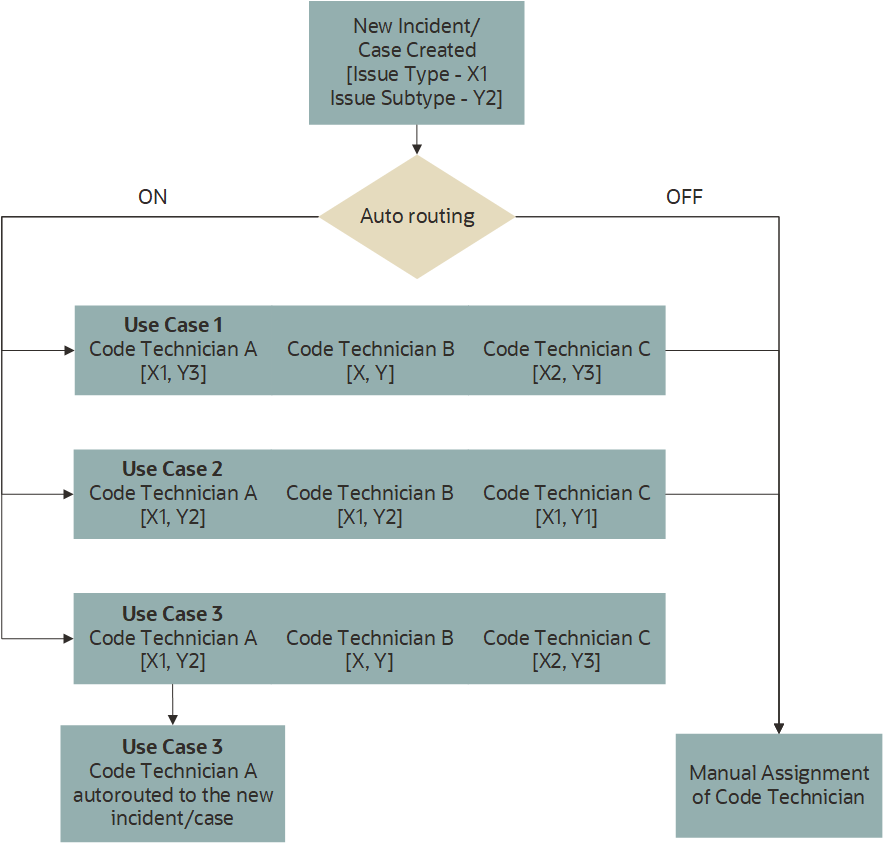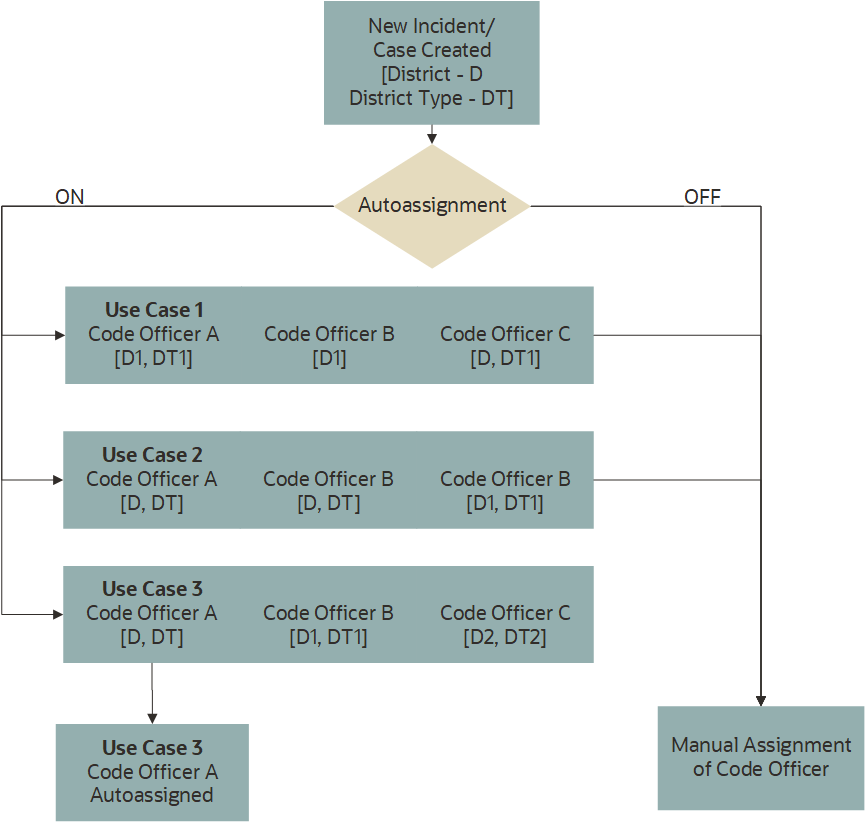Overview of Automatic Routing and Autoassignment
Agencies can set up newly created incidents and cases to be auto-routed to Code Enforcement Technicians and autoassigned to Code Enforcement Officers.
Setting Up Automatic Routing and Autoassignment
When agencies have automatic routing and autoassignment set up, incidents and cases get automatically routed or assigned to agency staff with the appropriate role and access rights.
When you set up the job functions for an agency staff, you can assign job specific attributes to an agency staff member. For example, you can assign the job function of a Code Enforcement Technician to an agency staff member and associate attributes such as Issue types and Subtypes. Similarly, you can assign the job function of a Code Enforcement Officer to an agency staff member and associate attributes such as District and District types.
For more information on issue types, issue subtypes, district types and districts, refer
The following examples show the job
attributes and values assigned to a code enforcement technician and officer. 

The following table will help you understand how newly created incidents and cases are auto-routed or auto assigned to agency staff based on their job functions and attributes.
|
Role |
Responsibility |
Setup |
|---|---|---|
|
Code Enforcement Technician |
Responsible for all Issue Types |
|
|
Code Enforcement Technician |
Responsible for one or more Issue Types |
|
|
Code Enforcement Technician |
Responsible for all Issue SubTypes |
|
|
Code Enforcement Technician |
Responsible for one or more Issue SubTypes |
|
|
Code Enforcement Officer |
Responsible for all District Types |
|
|
Code Enforcement Officer |
Responsible for one or more District Types |
|
|
Code Enforcement Officer |
Responsible for all districts within a District Type |
|
|
Code Enforcement Officer |
Responsible for one or more districts within a District Type |
|
Enabling Automatic Routing and Autoassignment
To enable automatic routing for Code Enforcement Technicians at the agency level options for code enforcement:
Select .
Click a row on the Agency Information tab.
Select the Features tab.
Click Options for the Code Enforcement offering.
The Code Enforcement Options window opens.
Under the General Settings section, enable the Automatically Route Issues switch.
To enable autoassignment for Code Enforcement Officers at the agency level options for code enforcement:
Select .
Click a row on the Agency Information tab.
Select the Features tab.
Click Options for the Code Enforcement offering.
The Code Enforcement Options window opens.
Under the Inspection section, enable the Autoassignment switch.
Automatic Routing of Code Enforcement Technicians
If you enable automatic incident and case routing on the Code Enforcement Options page, then incidents and cases are routed to Code Enforcement Technicians who are responsible for specific issue types and subtypes.
The diagram below shows a few use cases which illustrates how auto-routing incidents and cases to a technician works.

To define a technician’s areas of responsibility using the Issue Type and Issue Subtype attributes for the Code Enforcement Technician and Code Enforcement Supervisor job functions:
Assign a user to an issue type to make the user responsible for all related subtypes.
Assign an issue to a subtype when the user is not responsible for all of the subtypes that belong to the related issue type.
To give a user responsibility for all types of issues, create an Issue Type attribute row, but leave the attribute value blank.
When automatic routing is active, the Incoming Incidents tab on the Code Enforcement Technician worklists shows only the incidents in the user’s area of responsibility. Additionally, technicians can only reassign incidents to technicians who have the appropriate area of responsibility.
If there is only one code enforcement technician responsible for a particular issue type or subtype, then those issues are assigned to that technician automatically, and they don’t appear on the Incoming Incidents tab unless the technician releases the incident.
Code enforcement supervisors and technicians can assign or reassign incidents and cases to any technician. During this process, the list of available technicians is initially limited to those with the appropriate area of responsibility, but the supervisor can turn on the Show All Technicians switch to open up the list of all available technicians irrespective of their area of responsibility.
When automatic routing is active, incidents can only be updated by these users:
Users with responsibility for the incident’s issue type or subtype.
Users who are assigned to the incident, regardless of the user’s areas of responsibility.
Supervisors and super users such as a system administrator.
See Setting Up Agency-Level Options for Code Enforcement and Setting Up Agency Staff.
Autoassigning of Code Enforcement Officers
When an agency opts to use autoassigning, newly created incidents and cases can be autoassigned to an individual Code Enforcement Officer based on his or her job attributes.
The diagram below shows a few use cases which illustrates how autoassigning incidents and cases to an officer works.

A Code Enforcement Officer can be associated with one or more district and district types. Once a Code Enforcement Officer is associated with a district and district type, when a new incident or case is created with that district and district type, that Code Enforcement Officer gets autoassigned to the newly created incident or case.
If there are more than one Code Enforcement Officer available for the newly created incidents or cases, agency staff with the appropriate roles and permissions can claim those incidents and cases or do manual assignments for them.
Define a Code Enforcement Officer’s areas of responsibility using the District and District Subtype attributes for the Code Enforcement Officer job function:
Assign a user to a District Type to make the user responsible for all district under that district type.
Assign a District when the user is not responsible for all of the districts that belong to the related district type.
To give a user responsibility for all district types, create a District Type attribute row, but leave the attribute value blank.
When autoassignment is active, the Incoming Incidents tab on the Code Enforcement Officer worklist shows only the incidents in the user’s area of responsibility. Additionally, officers can only reassign incidents and cases to other officers who have the appropriate area of responsibility.
If there’s only one code enforcement officer responsible for a particular district or district type, then those incidents and cases are assigned to that officer automatically, and they don’t appear on the Incoming Incidents tab unless the officer releases the incident.
Code Enforcement agency staff, with the appropriate access, can assign or reassign incidents and cases to any officer. During this process, the list of available officers is initially limited to those with the appropriate area of responsibility. During the manual assignment or reassignment process, the agency staff can turn on the Show All Officers switch to open up the list of all available technicians irrespective of their area of responsibility.
When autoassigning is active, incidents and cases can only be updated by these users:
Users with responsibility for the incident's or case's district or district type.
Users who are assigned to the incident or case, regardless of the user’s areas of responsibility.
Supervisors and super users such as a system administrator.
For more information, see Claiming and Assigning Incidents and Reviewing and Claiming Cases.
For more information on agency staff, their job functions and attributes, see Setting Up Agency Staff.
For more information on enabling the autoassignment option at the agency level, see Setting Up Agency-Level Options for Code Enforcement.
Autoassigning Code Enforcement Officers to New Rerouted Cases
When a first inspection results in violation but with a change in the issue type and subtype, the newly created case can be automatically assigned to a Code Enforcement Officer based on the officer's job attributes. The system checks the updated issue type, issue subtype and the district type. If a Code Enforcement Officer is available with the matching district type, the officer is automatically assigned to the new rerouted case. If not, the case gets assigned to the officer who created it.